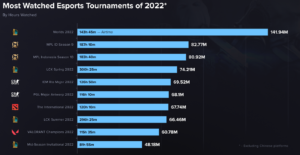Introduction
The entertainment industry and esports are deeply connected, forming part of a thriving ecosystem that has solidified its place in modern culture. Today, esports career opportunities are among the hottest topics in both discussions and investments, with the industry continuously evolving and expanding.
High-profile global brands are competing to secure their spots as sponsors for esports teams, recognizing the immense potential of this rapidly growing sector. Gaming venues are transforming their spaces into hubs for professional gaming, featuring dedicated streaming rooms, training facilities, and even fully equipped esports arenas designed for competitive 5v5 gameplay (for the uninitiated, that’s five players competing against another five!). From sports cafes to neighborhood pizzerias, it’s becoming increasingly common to see live streams of esports tournaments broadcast on large screens. Month by month, the popularity of esports continues to soar, capturing the attention of millions worldwide.
Despite its global reach, many still ask, “What does esports stand for?” or seek a clear esports definition. Questions about the industry’s financial structure, such as “Where does the money in esports come from?” or “Who are the esports athletes driving these competitions?” remain topics of curiosity. Additionally, the question of whether esports is in the Olympics continues to fuel discussions about its role on the global sports stage.
Esports is more than just competitive gaming; it’s an economic powerhouse and a marketing tool that brands use to connect with new audiences. From its humble beginnings in the 1970s to becoming one of today’s most-watched forms of entertainment, esports is redefining how we think about competition and community.
In this article, we’ll take a deep dive into the world of esports, exploring its history, organizational structure, and the incredible gaming job opportunities available. Whether you’re curious about when esports started, how esports tournaments work, or the opportunities in the industry, this guide will provide all the answers you’re looking for.
What is Esports?
In simple terms, esports refers to competitions between two or more players or teams in a video game. These contests can be either individual or team-based, mirroring traditional sports, but with athletes showcasing their skills through computer games.
Esports, short for electronic sports, is a form of competition using video games. Esports often takes the form of organized, multiplayer video game competitions, particularly between professional players, individually or as teams.

At first, glance, categorizing esports as a ‘sport’ may seem a bit far-fetched. But the reality is participation in any video game tournament demands severe physical and psychological preparation, much like traditional sports. For this reason, esports was officially recognized as a sport at the Olympic Games in 2021.
- There are over 200,000 video games worldwide (although, if we take into account indie games, the number actually exceeds one million). But out of all these, only about 8-10 are considered esports games or disciplines.
- Esports has broken into the top 10 most popular sports worldwide, with the American NFL sport currently holding the top spot.
- Esports is growing at a staggering rate of 25% per year.
- The total global audience for esports exceeds 600 million people. These statistics illuminate the incredible reach and impact of this digital phenomenon.
Today, China holds the title of the largest esports market in the world. The overall market value of esports is estimated at over 1 billion dollars, underscoring the significance of this form of sport and entertainment globally. Facts like these only highlight the importance and prominence of esports in our world today.
The History of Esports
There’s a wealth of information in the media sphere about the history of esports, with most sources pointing toward its emergence in Japan in the 1980s. This was the year when Taito Corporation unveiled a new video game – Space Invaders – to the world. Moreover, they announced an unprecedented global tournament for their video game. Arcades featuring Space Invaders popped up all over Japan and beyond its borders. These could be found in cafes, shops, hypermarkets, and even on the streets. That year, several tens of thousands of arcade machines were produced, and the tournament attracted over 50,000 participants.

The actual “catch” of Space Invaders lay in its competitive aspect. After all, players’ scores were displayed on a leaderboard on each arcade machine. The desire to break records and make it onto these leaderboards was widespread. This feature of Space Invaders was its ace in the hole, kick-starting the world of esports.
Following the advent of Space Invaders, successive video games and arcade machines strove to incorporate similar ranking or competitive systems. This marked the beginning of the competitive digital gaming landscape we now recognize as esports.
The Evolution of Esports
For a long time, esports evolved slowly, often used as a marketing tool. For instance, when a new video game with competitive elements was released, tournaments would be organized around it. This attracted players, and the product received advertising and publicity. This method still works to this day, but its impact on the development of esports is less significant.
Esports started to increase with the emergence of gaming venues, and these venues began hosting the first full-fledged tournaments, fostering the development of esports and the community around it. After some time, ‘Tournament Operators’ took over esports’ growth and tournaments’ organization. However, today, organizing tournaments in gaming venues has regained its popularity, which is a positive development. Moreover, the presence of full-fledged 5v5 esports arenas and viewing zones for esports matches are becoming increasingly common.
Around the world, universities and colleges are introducing faculties and entire programs dedicated to esports. These educational programs train future professionals in the esports niche and esports athletes. In addition, established esports teams are opening their academies, where they train and prepare young esports athletes.
Esports has become so popular that its events are followed by millions of viewers worldwide. The most popular esports discipline is considered to be the video game League of Legends. In 2022, the League of Legends World Championship was watched by nearly 142 million viewers in total.

*Most popular esports tournaments in 2022
Viewership is a crucial indicator in both esports and traditional sports. It demonstrates not just the number of fans of a particular discipline but also implies advertising integrations and media rights sales. I will delve into this topic further down.
Esports Athlete
It is a misconception to consider any player who sits and plays a video game an esports athlete. A real esports athlete must possess not only gaming skills but a range of essential qualities and abilities, such as:
- Non-standard, logical, and analytical thinking
- Reaction speed
- Ability to work and communicate in a team, understanding the behavior of others
- Ability to interact with information
- Practicality
- Prudence
- Adaptability
- Psychological resilience
Team players earn the most in esports. They receive monetary rewards from the prize pool and have relatively high contracts, sponsorships, and additional income from their media resources. Currently, the highest-paid esports player is Johan Sundstein, known as “N0tail”. As of today, he has earned $7.18 million. He is a member of the European Dota 2 team “OG.”

In general, if we take a portrait of an average esports athlete, we would get the following picture – typically, these are young men aged between 15 and 25, with salaries ranging from $100 to $20,000. However, considering the average esports player’s salary for 2022, the amount is around $5,000, and contracts with some players can reach up to $4,000,000.



Esports Organization
Many people do not know how huge an esports organization can be or how much total capital it can accumulate. Forbes research in 2020 revealed that TSM is the most valuable esports organization, with an estimated worth of $410 million.

An esports organization is a fully-fledged company with a coordinated team of dozens of specialists in various fields.
As you can see, there are numerous professions in esports. That’s why opening esports faculties in institutes, academies, and even cyber clubs is becoming increasingly popular.
Gaming Venues as Part of the Ecosystem
Gaming venues have always been and continue to be a part of the global esports ecosystem. It is in these venues that many current esports athletes first started playing and training. A future esports professional may sit and play in one of your local gaming cafes. This is why such venues should actively promote esports culture and attract customers.
For instance, in Brazil and Latin America overall, it has long been popular to invite esports athletes to cyber cafes to conduct training sessions and lectures for those interested. In Central Asia, it is increasingly common to see particular areas for viewing esports events in the halls of cyber cafes. Similarly, there are often separate, closed rooms for streaming and training.
Various government bodies have been increasingly seeking assistance from gaming venue owners in organizing esports events, using it as a tool for their PR and developing esports in the country.
Overall, cyber cafes are wonderful places for the community, uniting people around a common passion for computer games and esports.
Where's the Money in Esports?
This question intrigues many. Tournament prizes? Yes, they are substantial and sometimes reach a whopping $40 million. However, these are earned solely by the winners, after tax deductions, and in practice, almost all of this money goes to the players – the esports athletes – rather than the team owners or tournament organizers.
So what does the entire esports ecosystem rely on?
SPONSORSHIPS MERCHANDISE AND TICKET SALES MEDIA RIGHTS STREAMING
The primary income in esports undoubtedly comes from sponsors. Sponsors invest money in both the organization of tournaments and esports teams and individually in players, all for advertising and PR.

Source: statista.com
The sale of media rights generates roughly as much profit as streaming. Despite the COVID-19 pandemic, ticket and merchandise sales continue to grow yearly. According to the Statista Advertising and Media Outlook, revenue derived from each esports segment is expected to grow by a few percentage points every year.
Global Esports Ecosystem
To sum it up, let’s compile all the information we’ve gathered and form a comprehensive esports ecosystem together.
- Game Developers.
Without video games, there would be no esports, so they are undoubtedly part of the ecosystem. - Tournament Operators.
Next on the list are the tournament operators. These are organizations like ESL, WePlay Esports, DreamHack, and others that host tournaments for various disciplines worldwide. We’re talking about offline events that attract esports teams, sponsors, and media. - Broadcasting.
Events need to be broadcasted, which relates to the broadcasting sector, which also includes the sale of media rights. - Esports Teams.
Esports teams, as well as individual esports athletes (in solo disciplines), play a crucial role and create demand in the services market for various team and player management agencies. - Team Management Agencies + Cyber Cafes.
Cyber cafes play a vital role in the esports ecosystem. They serve as venues for local and qualifying tournaments, breeding grounds for potential esports athletes, and aid in community building. - Tournament Platforms.
Online tournament platforms foster and support esports. They allow the organization and hosting of tournaments for anyone interested. You don’t have to be an esports athlete to participate in a tournament, win prizes, and earn recognition from other players. - Talent and Staff.
It’s essential not to forget the people “behind the scenes.” Hundreds, if not thousands, of people from various specialties work on broadcasting and event preparation. - Media.
Thousands of media resources regularly publish esports news, reviews, and statistics. This is an inexhaustible source of traffic for many business sectors and sponsors.
Conclusion
As you can see, this is a mechanism where each cog works to support a massive organization called esports. Not too long ago, much of the above was only in the project stage and seemed insignificant. But esports evolves like any other ‘organism,’ whether it’s a business or a product. New niches and directions open up in it that did not exist before, and we do not know what esports will look like in 5-10 years.
Perhaps in the near future, there will be new esports disciplines using VR (Virtual Reality) or AR (Augmented Reality) devices.
It’s intriguing to wait and see what role gaming venues, which have started to actively develop in this direction, will play in the esports ecosystem.
Lastly, I would like to share some interesting facts from the world of esports with you.
Facts and Myths about Esports
- The first tournament occurred between students at Stanford University as early as 1972, and its winner received a subscription to Rolling Stone magazine. [FACT]
- 45% of gamers in America are women. [FACT]
- There is anti-doping control in esports. [MYTH]
While this is not the case yet, it is heading in that direction. The use of psychotropic substances to increase concentration and reaction time is not new, so such control bodies may appear in esports soon. - Previously, the concept of “esports” or “tournament” could be equated to marketing – as a tool for boosting game sales and PR in general. [FACT]
- After the release of Space Invaders in Japan, the game became so popular that it led to a shortage of 100 yen coins. This was even mentioned in the “Guinness Book of Records.” [MYTH]
This is a coincidence. That year, the bank stopped issuing coins of this denomination. - The largest and most popular esports tournaments are held in the League of Legends (League of Legends World Championship) discipline. [FACT]
- In traditional sports, the average revenue per fan is $15, while in esports, it is up to $5. [FACT]
- As of October 2022, Dota 2 has the largest cumulative prize pool in esports ($290.54 million). [FACT]
- The Free Fire World Series, 2021 in Singapore, peaked at 5.4 million viewers and set a new world record! [FACT]
- In 2023, the annual prize pool of esports is expected to exceed $500 million. [FACT]
- Approximately 80% of Americans are not interested in or have never heard of esports. [FACT] They have the NFL?
FAQ
What does esports stand for?
Esports stands for electronic sports, referring to competitive video gaming at a professional level. It involves skilled players competing in games such as League of Legends, CS:GO, and Fortnite.
How do esports tournaments work?
Esports tournaments are structured competitions where players or teams compete for prizes, rankings, and recognition. These can range from small local events to massive global championships, such as the League of Legends World Championship or The International (Dota 2).
Are esports considered real sports?
Esports share many similarities with traditional sports, such as strategy, teamwork, and competition. However, they differ in that they are played in a digital environment rather than a physical one.
Is esports in the Olympics?
While esports are not yet officially part of the Olympic Games, they have been recognized by the International Olympic Committee (IOC). Esports were featured in the 2023 Olympic Esports Week, showcasing their growing relevance in global sports.
When did esports start?
Esports began in the early 1970s, with one of the first known competitions being held at Stanford University in 1972 for the game Spacewar. The industry gained significant traction in the late 1990s with the rise of online multiplayer games and global tournaments.
What is the esports definition?
The esports definition refers to competitive video gaming as a professional sport, involving organized events, skilled players, and a global audience. It’s a rapidly growing industry that blends entertainment and competition.

